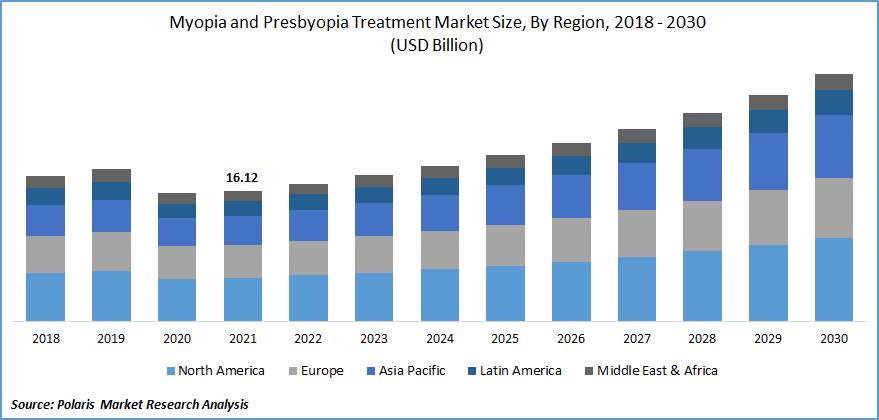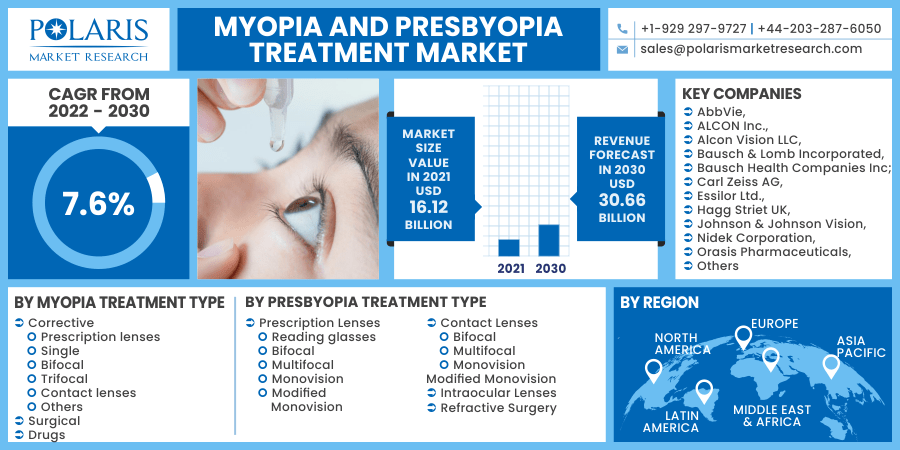
Myopia and Presbyopia Treatment Market Share, Size, Trends, Industry Analysis Report, By Myopia Treatment Type (Corrective, Surgical, Drugs), By Presbyopia Treatment Type (Prescription Lenses, Contact Lenses, Intraocular Lenses, Refractive Surgery); By Region; Segment Forecast, 2022 - 2030
- Published Date:Mar-2022
- Pages: 118
- Format: PDF
- Report ID: PM2313
- Base Year: 2021
- Historical Data: 2018 - 2020
Report Outlook
The global myopia and presbyopia treatment market was valued at USD 15.82 billion in 2021 and is expected to grow at a CAGR of 7.6% during the forecast period. The vision correction treatments for eye disorders bear outstanding results and have an immense scope of advancement. However, results for presbyopia are not compelling, thus presenting the vast potential for development. The increasing prevalence of Myopia and Presbyopia globally is anticipated to drive myopia and presbyopia treatment market's growth.
 Know more about this report: request for sample pages
Know more about this report: request for sample pages
According to WHO (World Health Organization), more than 2.1 billion people globally and over 128 million in the U.S. will have presbyopia in 2020. Out of these people, over one-third are over the age of 50. Further, over 826 million people are affected by unaddressed presbyopia. The increasing number of recent developments made by major industry players are anticipated to drive industry growth. For instance, In October 2021, Allergan received the approval of the FDA (Food & Drug Administration) for Vuity (pilocarpine hydrochloric acid ophthalmic solution) 1.25%, used for the cure of presbyopia.
The spread of the COVID-19 reflects the downfall in the industry growth on account of the disruptions in the supply chain, lockdown measures, and limited consumer spending. Further, as small & medium practices have completely been shut down due to lockdown globally is anticipated to hinder the market growth.
However, the increasing damage to the eyesight of the population is due to the growing screen time of smartphones, tablets, and other media consumption devices. According to a survey report by Feel Good Contacts based in the U.K., the Indian population suffered the maximum damage to eyesight during the lockdown period. Around 23% of the population reported weakening eyesight due to excessive screen time.

Know more about this report: request for sample pages
Industry Dynamics
Growth Drivers
The primary factor driving the industry's growth is the rising prevalence of myopia. This is further anticipated to boost the demand for such products utilized to treat these conditions. Myopia and presbyopia are highly common ophthalmic conditions and occur among all ages. Consequentially, the growing use for surgeries such as LASIK and the introduction of advanced lenses are projected to drive the growth of the global industry. These LASIK surgeries are gaining huge traction globally due to the rising awareness of the benefits of long-term solutions.
Advanced lenses such as implantable contact lenses and intraocular phakic presbyopic lenses are gaining popularity because of their benefits, including being less prone to dry eyes and others. Additionally, the rising population above the age of 65 is also anticipated to act as a catalyzing factor for industry growth. Moreover, increasing investments in research & development by key industry players to enable early diagnosis and to identify quick & efficient solutions is also offers several lucrative opportunities for industry development across the globe.
Report Segmentation
The market is primarily segmented on the basis of myopia treatment type, presbyopia treatment type, and region.
|
By Myopia Treatment Type |
By Presbyopia Treatment Type |
By Region |
|
|
|
Know more about this report: request for sample pages
Insight by Myopia Treatment Type
The corrective segment holds the largest revenue share in 2021 and is expected to lead the market in the forecasting years. The rising cases of myopia are the primary factors that are attributing to the segment growth worldwide. Corrective lenses are one of the most effective treatment options to correct the blurred vision caused by myopia. The changing lifestyle of the global population, including the reduction in time spent outside rising adoption of work from home culture, among others, is anticipated to boost the segment's growth.
The surgical segment is projected to witness a progressive growth rate in the forecasting years. The segment's growth can be attributed to the increasing patient pool globally. In addition, the growing number of technological advancements in the development of surgical equipment coupled with the decreasing service costs are anticipated to drive the growth of the segment. Additionally, the benefits offered by surgery associated with the increasing popularity of the solution across developed nations are expected to present substantial growth opportunities for the segment.
Geographic Overview
Geographically, North America accounted for the largest revenue share in the global market in 2021. This vast market share can be attributed to the rising investments in healthcare by private and government bodies in order to offer better healthcare facilities to the population in North America.
The presence of key market players in the U.S. and the rising consumer awareness is anticipated to provide tremendous market growth opportunities. Furthermore, the increasing demand for advanced eye care solutions is expected to drive the market's growth. Advanced ophthalmic diagnostic products are gaining traction for the timely identification of myopia and presbyopia.
Moreover, the Asia Pacific myopia and presbyopia treatment market is expected to exhibit the highest CAGR over the forecasting years. The increasing number of manufacturers investing and the growing availability of better healthcare options across the region are the primary factors that contribute to market growth. Further, the market's growth is fueled by rapid urbanization, improving living standards, and rising disposable income of the population in the emerging nation.
Competitive Insight
Some of the major players operating in global myopia and presbyopia treatment market include AbbVie, ALCON Inc., Alcon Vision LLC, Bausch & Lomb Incorporated, Bausch Health Companies Inc., Carl Zeiss AG, Essilor Ltd., Hagg Striet UK, Johnson & Johnson Vision, Nidek Corporation, Orasis Pharmaceuticals, Regeneron Pharmaceuticals Inc., Sydnexis, The Cooper Companies Inc., Topcon Corporation, and Zimmer Ophthalmic Systems AG.
Myopia and Presbyopia Treatment Market Report Scope
|
Report Attributes |
Details |
|
Market size value in 2021 |
USD 16.12 billion |
|
Revenue forecast in 2030 |
USD 30.66 billion |
|
CAGR |
7.6% from 2022 - 2030 |
|
Base year |
2021 |
|
Historical data |
2018 - 2020 |
|
Forecast period |
2022 - 2030 |
|
Quantitative units |
Revenue in USD million and CAGR from 2022 to 2030 |
|
Segments covered |
By Myopia treatment type, By Presbyopia treatment type, By Region |
|
Regional scope |
North America, Europe, Asia Pacific, Latin America, Middle East & Africa |
|
Key Companies |
AbbVie, ALCON Inc., Alcon Vision LLC, Bausch & Lomb Incorporated, Bausch Health Companies Inc., Carl Zeiss AG, Essilor Ltd., Hagg Striet UK, Johnson & Johnson Vision, Nidek Corporation, Orasis Pharmaceuticals, Regeneron Pharmaceuticals Inc., Sydnexis, The Cooper Companies Inc., Topcon Corporation, and Zimmer Ophthalmic Systems AG. |
